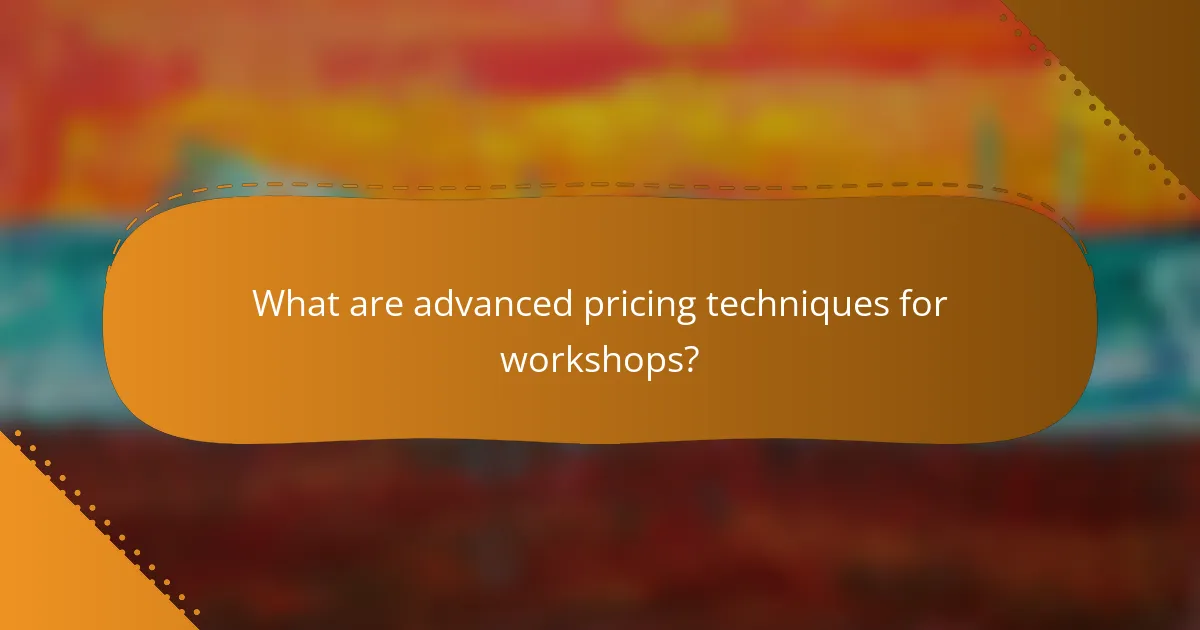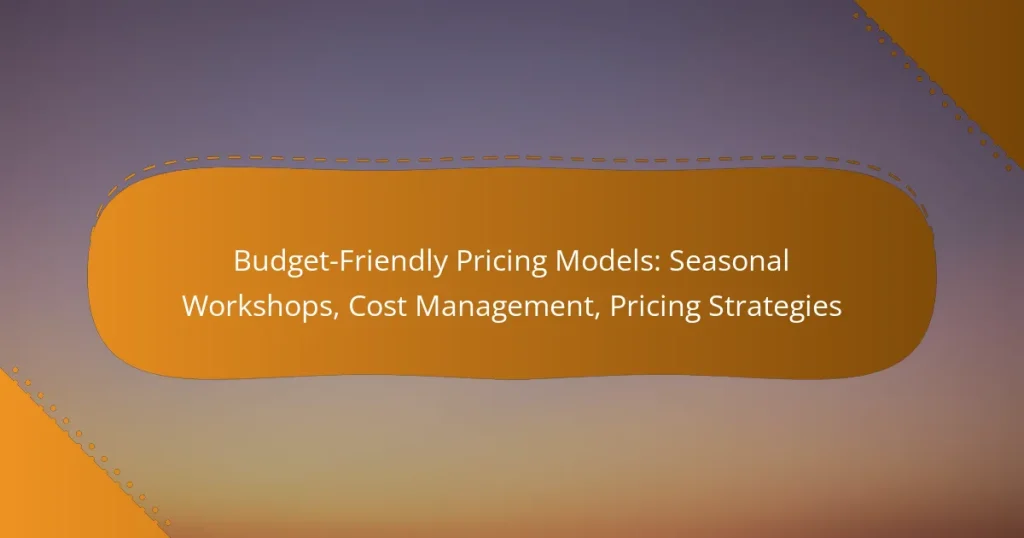Budget-friendly pricing models for seasonal workshops aim to enhance accessibility while boosting attendance through tailored pricing options for diverse customer segments. By implementing effective cost management strategies, organizers can improve profitability and offer competitive rates without compromising quality. Additionally, employing innovative pricing strategies can align costs with perceived value, attracting more participants and maximizing engagement.

What are budget-friendly pricing models for seasonal workshops?
Budget-friendly pricing models for seasonal workshops are strategies designed to make participation more affordable while maximizing attendance. These models often include various pricing options that cater to different customer segments, helping to ensure that workshops are accessible to a wider audience.
Tiered pricing structures
Tiered pricing structures offer multiple pricing levels based on factors such as registration timing or participant benefits. For example, a workshop might have a basic tier for general access and a premium tier that includes additional materials or one-on-one sessions. This approach can attract a diverse range of participants, from budget-conscious individuals to those willing to pay more for added value.
When implementing tiered pricing, consider setting clear benefits for each level to justify the price differences. A common practice is to offer the basic tier at a low price, such as $50, while premium tiers could range from $100 to $200, depending on the inclusions.
Early bird discounts
Early bird discounts incentivize participants to register well in advance by offering reduced rates. This model not only helps in securing early commitments but also aids in planning and resource allocation for the workshop. Discounts can vary, typically ranging from 10% to 30% off the regular price.
To effectively use early bird discounts, set a clear deadline for registration, such as one month before the workshop date. Promote this offer through email campaigns and social media to create urgency and encourage quick sign-ups.
Group rates
Group rates provide discounts for bulk registrations, making it more affordable for teams or organizations to participate together. This pricing model can foster community engagement and increase overall attendance. Group discounts often range from 15% to 25% off the standard rate, depending on the number of participants.
When offering group rates, establish a minimum number of participants required to qualify for the discount, such as five or more. Clearly communicate the savings and benefits of attending as a group to encourage organizations to take advantage of this offer.

How can cost management improve workshop profitability?
Effective cost management can significantly enhance workshop profitability by minimizing expenses and maximizing resource utilization. By strategically controlling costs, workshop organizers can increase their margins and offer competitive pricing without sacrificing quality.
Reducing overhead expenses
Reducing overhead expenses involves identifying and cutting unnecessary costs associated with running a workshop. This can include negotiating better rates for venue rentals, using shared spaces, or opting for off-peak times when rates are lower.
Consider implementing a budget review process to track all expenses. Regularly assess contracts with suppliers and service providers to ensure you are getting the best deals available.
Utilizing volunteer staff
Utilizing volunteer staff can significantly lower labor costs while still providing valuable support. Engaging volunteers not only reduces payroll expenses but also fosters community involvement and enthusiasm for the workshop.
To attract volunteers, clearly outline the benefits they will receive, such as skill development, networking opportunities, or even free attendance to the workshop itself. Ensure that roles are well-defined to maintain efficiency and satisfaction among volunteers.
Implementing technology for efficiency
Implementing technology can streamline operations and reduce costs in various areas of workshop management. Tools such as online registration platforms, automated email reminders, and project management software can save time and minimize errors.
Investing in technology may have upfront costs, but the long-term savings can be substantial. For instance, using an online ticketing system can reduce administrative workload and improve cash flow by collecting payments in advance.

What pricing strategies attract more participants?
Effective pricing strategies can significantly increase participant numbers by aligning costs with perceived value and market demand. By implementing approaches like dynamic pricing, value-based pricing, and bundled offerings, organizations can optimize their pricing models to attract a larger audience.
Dynamic pricing based on demand
Dynamic pricing adjusts prices based on real-time demand and market conditions. This strategy can be particularly effective for seasonal workshops, where interest may fluctuate significantly. For example, prices might increase during peak registration periods or decrease during off-peak times to encourage participation.
To implement dynamic pricing, monitor registration trends and competitor pricing closely. Tools that analyze demand patterns can help set optimal price points. However, be cautious of pricing too high during low demand, as it may deter potential participants.
Value-based pricing
Value-based pricing focuses on setting prices based on the perceived value of the workshop to participants rather than solely on costs. Understanding what participants value—such as expert instruction or unique content—can help in determining a suitable price. For instance, workshops that offer exclusive insights or certifications can command higher prices.
To effectively use this strategy, conduct surveys or gather feedback to gauge what aspects participants find most valuable. This approach can lead to higher satisfaction and retention rates, as participants feel they are receiving good value for their investment.
Bundled offerings
Bundled offerings combine multiple services or products into a single package at a discounted rate, making them more attractive to participants. For example, a workshop could include additional resources like e-books or follow-up sessions as part of a bundle. This not only enhances perceived value but also encourages participants to enroll.
When creating bundles, ensure that the combined offerings are relevant and appealing to your target audience. Avoid overwhelming potential participants with too many options; instead, focus on a few well-curated bundles that highlight key benefits. This strategy can lead to increased sales and participant engagement.

What criteria should be considered for selecting pricing models?
When selecting pricing models, consider factors such as your target audience, market competition, and overall cost management strategies. These elements will help you create a pricing structure that is both appealing to customers and sustainable for your business.
Target audience analysis
Understanding your target audience is crucial for effective pricing model selection. Analyze demographics, purchasing behavior, and price sensitivity to tailor your offerings. For example, if your audience consists of budget-conscious consumers, consider lower price points or discounts to attract them.
Conduct surveys or focus groups to gather insights about what your audience values most. This can inform whether to adopt a subscription model, one-time payment, or tiered pricing based on features or service levels.
Market competition assessment
Assessing market competition is essential to determine how your pricing stands against similar offerings. Research competitors’ pricing strategies to identify gaps or opportunities in the market. For instance, if competitors charge premium prices, you might consider a value-based pricing model to capture a different segment.
Utilize tools like price comparison websites or market analysis reports to gauge where your pricing fits. Be cautious of underpricing, as it can devalue your product and affect profitability. Aim for a competitive edge by highlighting unique features or benefits that justify your pricing strategy.

How do seasonal trends affect pricing strategies?
Seasonal trends significantly influence pricing strategies by dictating demand fluctuations throughout the year. Businesses can optimize revenue by adjusting prices according to peak and off-peak seasons, allowing for better cost management and customer engagement.
Adjusting for peak seasons
During peak seasons, demand typically surges, allowing businesses to increase prices without losing customers. For example, a ski resort may raise rates during winter holidays when visitor numbers are high. It’s essential to analyze historical data to determine peak periods and set competitive yet profitable pricing.
Consider implementing dynamic pricing strategies that adjust in real-time based on demand. This approach can maximize revenue during high-demand periods while ensuring you remain attractive to customers. Just be cautious of overpricing, which can drive customers to competitors.
Identifying off-peak opportunities
Off-peak seasons present unique opportunities for businesses to attract customers through lower pricing strategies. For instance, a hotel might offer discounted rates during the summer months when fewer guests travel. This can help maintain cash flow and occupancy rates during slower times.
To effectively identify off-peak opportunities, analyze customer behavior and market trends. Offering promotions, bundling services, or creating loyalty programs can incentivize purchases during these periods. Avoid relying solely on discounts; instead, focus on enhancing the overall value proposition to encourage customer engagement.

What are advanced pricing techniques for workshops?
Advanced pricing techniques for workshops include strategies that optimize revenue while attracting participants. These methods focus on psychological factors, subscription models, and other innovative pricing structures to enhance affordability and value perception.
Psychological pricing
Psychological pricing leverages consumer behavior to influence purchasing decisions. This technique often involves setting prices just below a round number, such as pricing a workshop at $99 instead of $100, which can make the cost seem significantly lower.
Consider using tiered pricing to create perceived value. For example, offering a basic workshop for $50, an advanced one for $100, and a premium package at $150 can encourage participants to opt for higher-priced options due to the perceived benefits.
Subscription models
Subscription models provide a steady revenue stream by charging participants a recurring fee for access to multiple workshops over time. This approach can enhance customer loyalty and reduce the barrier to entry for new attendees, as they may be more willing to commit to a lower monthly fee.
When implementing a subscription model, consider offering different tiers based on access levels. For instance, a basic subscription could include access to monthly workshops, while a premium tier might offer exclusive content or one-on-one coaching sessions. This flexibility can cater to various budgets and preferences, making workshops more accessible.


